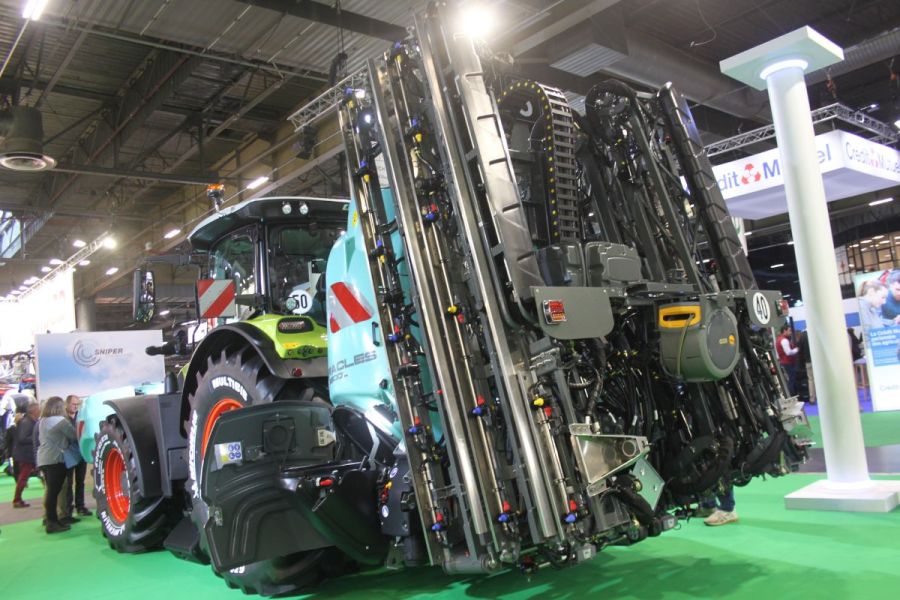With the move of France’s SIMA international farm machinery exhibition to a November date in ‘even’ years, manufacturers were spoilt for choice when it came to unveiling new developments, with Italy’s EIMA in the same month. With both nations having strong machinery manufacturing bases, the crowded calendar didn’t affect the flow of innovation.
By Martin Rickatson
Accounting for 37% of tractor sales across Europe in the first half of 2022, the French tractor market is a good bellwether for the state of the country’s – and perhaps the continent’s – agriculture. As an extension of that, the country’s biennial SIMA farm machinery exhibition, which attracts visitors and exhibitors from across Europe, provides a good measure of the mood of the nation’s farmers.
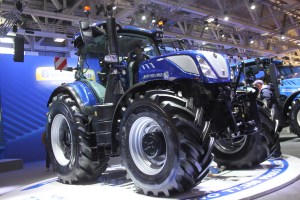
Despite both SIMA and EIMA falling in November, manufacturers – such as New Holland with its new T7.300 – had plenty to show.
A new show timing – in November of ‘even’ years rather than its traditional slot in February of ‘odd’ ones – meant the past autumn was a little crowded with international machinery exhibitions, with the Italian EIMA exhibition taking place in the same week. Nevertheless, the two events provided the opportunity for different windows on the current state of agriculture in two of Europe’s most significant crop-producing nations, and plenty of new developments across the arable machinery sector were launched at both.
In France, first-time tractor registrations were down 3% in the first half of 2022, compared with the same period last year. However, that was still well above the average for the same period over the previous five years, with 2021 having been exceptional in terms of investment in agricultural equipment, according to CEMA, the European agricultural machinery association.
After a good first quarter as French farmers chose to invest with cautious optimism, new tractor registrations began to decline in April. CEMA suggests supply and delivery difficulties were among the key factors behind the decline in the volume of registrations, although it’s not clear to what extent. Splitting apart the specialist crop sectors and removing the smaller and specialist tractors, CEMA calculates that the agricultural tractor market for the first half of 2022 was down by around 5%.
Italian market holding up
Meanwhile, although the Italian market for agricultural machinery of all types is on a downturn, according to industry association FederUnacoma, this is from a strong performance in 2021. It recorded registrations of 15,800 agricultural tractors in the nine months from January to September 2022, down on the same period in 2021 but still higher than the average of the last four years. At EIMA’s opening press conference, association president Alessandro Malavolti suggested delays in the supply chain, rising production costs and the resulting increase in list prices are holding back the agricultural machinery market.
“Despite these issues, machinery sales levels are holding up well,” he said.
“Registration statistics processed by FederUnacoma on the basis of data provided by Italy’s Ministry of Transport indicate a 15.3% drop for tractor registration volumes in the first ten months of the year. But as the average over those months in recent years was around 14,000 units, farmers here are clearly still prioritising investment over consolidation.
FederUnacoma also recorded a 14% drop in registrations of combines for the past harvest season, with 335 units recorded, an 11.6% drop compared with a market that had broken the 350 barrier the previous year. Telescopic handler sales into agriculture closed the ten months with a drop of 24% at 964 units.
New in sprayers
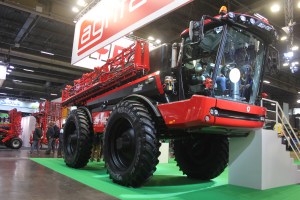
Dutch manufacturer Agrifac introduced the Vanguard to its Condor range, with a 6000-litre tank but an overall width of 2.55m.
In the sprayer sector, introductions at SIMA spanned everything from mounted machines to self-propelled ones. In the latter category, Dutch manufacturer Agrifac introduced the Vanguard to its Condor range, as a companion to the Condor V and Condor Endurance. Despite a 6000-litre tank, a key attribute is reckoned to be its overall width of 2.55m, while it also offers 75cm of adjustable track width. Maximum available track widths are either 1.8m on StabiloPlus chassis models or 3.0m on WideTrackPlus versions. Its engine is a 6.7-litre six-cylinder Cummins producing 288hp, and top travel speed is 50 km/hr with a maximum tyre size of 480/95 R50 (2.2m diameter).
With Balance Plus stabilisation the boom can work as close as 30cm from the ground, says the maker. Boom widths are from 24-48m, and options include Agrifac’s AirFlowPlus air assistance system, which boosts crop penetration by using fans sited every three metres along the boom.
French firm Berthoud’s latest mounted machine is targeted at mid-sized farms with hilly ground that doesn’t suit typical hydrostatic SP sprayers or the trailed type, which tend to require complex and expensive steering systems to track true behind the tractor. The company claims that when combined with a front tank a modern mounted sprayer can match a small self-propelled for output.
The new Heracles Evo replaces its Elyte model and can be had with a tank capacity of up to 2000 litres, a jump of 500 litres on the largest Elyte. It can be paired with a newly-designed 1000- or 1500-litre front tank, with attributes said to include improved emptying and enhanced vision. Booms are a new ASLR three- or four-section design from 21-30m, and the sprayer’s specification can include individual nozzle control and pulse width modulation while quad nozzle bodies are standard, as is ISOBUS control. There’s also a new front-rear transfer system which keeps the relative content of both tanks equal as the liquid is applied, to aid weight distribution and traction.
John Deere chose SIMA to announce that its ‘See & Spray’ system, already offered in the USA, will be an option for its R900i trailed sprayers from 2023. It uses camera technology integrated into the sprayer boom to detect colour differences in the field, with one camera per metre of working width. Processors assess the images and the nozzles are triggered individually for spot treatment. Green detection on the field soil enables targeted application of pre-emergence herbicides, suggests Deere. Beyond pre-em use, the system is also suited to work in row crops post-emergence.
Crop establishment innovations
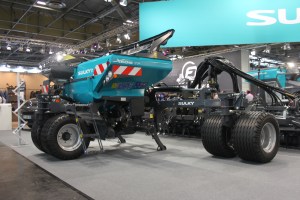
Sulky’s prototype press wheels extend hydraulically out beyond the tractor to consolidate the soil ahead of the outer reaches of the drill behind.
French firm Sulky showed a prototype of a new consolidation arrangement for use with drill combinations, designed to extend the established idea of a set of press wheels carried on the tractor’s front linkage. With the displayed arrangement, which operates in combination with its Xeos TF front-mounted hopper, pairs of press wheels are extended hydraulically out beyond the tractor to consolidate the soil ahead of the outer reaches of the drill behind. The units pivot upwards for transport. Sulky says that the idea is currently still in the testing and development stage.
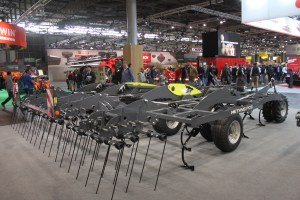
Sky’s Methys PCS shallow cultivator is designed for slicing through root matter at depths of around around 5cm (2in). A 6m unit features 29 A-share equipped tines set across seven rows.
Those seeking a shallow cultivator for slicing through combinable crop root matter at depths of around 5cm (2in) now have another option with the launch of the new Methys PCS from Sky Agriculture, whose products come into the UK via Opico. Available currently in 6m and 8m trailed folding versions, mounted models from 3m are in development. A 6m unit features 29 A-share-equipped tines set across seven rows, with each transport/carrying wheel being followed by a tine so that cultivated ground does not become recompressed. Three rows of finishing tines follow up at the rear, designed to ensure that as much soil as possible is removed from plant root material to speed drying and degradation. The tandem front wheels help ensure accurate depth control, says Sky.
Drill developments
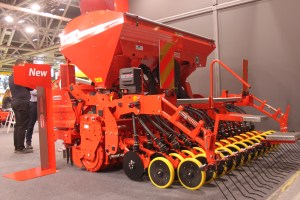
Maschio Gaspardo’s Alitalia combination drill now features upgrades including a redesigned hopper and external distribution heads.
Sold in the UK by importer Opico, Maschio Gaspardo’s Alitalia combination drill now features a number of upgrades for next season. A redesigned hopper means easier access and new external distribution heads, with the unit now holding 2000 litres of seed. Each head has its own volumetric distributor with electric transmission, which Maschio says boosts seed movement precision and means automatic GPS-governed shut-off of the right or left half of the coulter bar is possible, according to the drill’s location detected by the GPS sensor. Electric metering for each side also means variable rate sowing is possible. Coulter choice spans Suffolk, single disc, double concave disc or double straight disc types.
Other drill news at EIMA included the purchase by Austria’s Pöttinger of Italian precision drill specialist MaterMacc, formerly part of the Chinese Lovol group which has withdrawn its Arbos tractor operation from Europe. Matermacc remains an independent brand and business for now, with Pöttinger retaining its factory, workforce and product line. The firm won an EIMA Innovation Award for its new MiPlus EVA precision drill control terminal, which allows key functions to be operated and altered via voice commands.
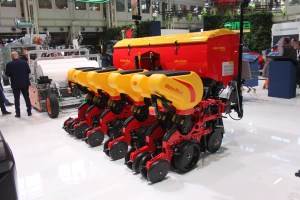
Italian precision drill specialist Matermacc is now under the ownership of Austria’s Pöttinger, it was announced just prior to the EIMA show.
Tractor news
Both Case IH (Puma) and New Holland (T7) launched new 280hp long wheelbase tractors at SIMA and EIMA. New Holland’s T7.300 features an FPT Industrial NEF 6 delivering 280hp maximum power for draft work and 300hp for PTO and haulage tasks. Fitted with a new electronically-controlled variable geometry turbo, it meets Stage V emissions standards using New Holland’s Hi-eSCR after-treatment system, with no exhaust gas recirculation.
Further engine-related details include 18% more fuel capacity and lengthened service intervals. New Holland has also extended the tractor’s overall capabilities with increased axle capacities and a higher gross vehicle weight. Maximum rear tyre diameter is 2.05m. There is a larger, quieter (66 decibels) cab interior with enhanced materials and a new Comfort Ride suspension that co-ordinates cab and front axle damping.
Other new features include decouple-under-pressure remote valves with configurable controls. The tractor also features Tractor Implement Management (TIM), which allows two way communication between tractor and implement and for the latter to control functions of the former.
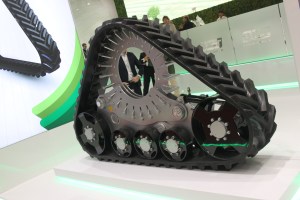
Tyre manufacturer BKT has now entered the market for replacement rubber tracks, with these Agriforce BK T71 units.
Elsewhere in terms of tractor developments, Indian firm BKT, which has built a significant presence in agricultural tyres over recent years from a standing start, is now in the replacement rubber track market. Its Agriforce BK T71 units are manufactured from what it describes as a ‘high performance’ formulation designed to provide strong resistance against cuts, tears and abrasion. An optimised tread pattern, resulting from the firm’s own research, is reckoned to maximise traction and ride comfort. The shape of the positive-drive lugs ensures full positive engagement, and the carcase is reinforced with four layers of high-tensile steel cord.
Deutz-Fahr has added three new 136-156hp 6.4 designation models to its existing 6 series, between the 6C and 6 ranges. The four-cylinder tractors, which have a 2.56m wheelbase, are built around SDF’s own powertrain and front axle, with electro-hydraulically engaged 4wd and 100% lockable diff lock. Transmission options comprise SDF’s continuously-variable TTV and the recently-introduced RVshift CVT/powershift hybrid, a full powershift concept with definable pre-determined ratios that can also be customised according to task and preference.
This article was taken from the latest issue of CPM. For more articles like this, subscribe here.

